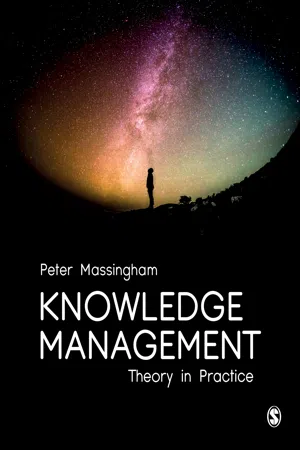
Knowledge Management
Theory in Practice
Peter Massingham
- 528 pages
- English
- ePUB (mobile friendly)
- Available on iOS & Android
Knowledge Management
Theory in Practice
Peter Massingham
About This Book
An overview of what knowledge management is, the theoretical basis behind it, and practical insights into how it can be implemented effectively in a professional setting.
Starting with a discussion ofhow knowledge management has evolved, how it adds value for organisations, and how it?s success can be measured. The book then covers best practice and the key activities associated with doing knowledge management, including knowledge strategy, managing knowledge loss and knowledge sharing. Finishing with a discussion of knowledge management's role in international business and what future developments are expected in the field.
Practical insights are drawn from around the world, with case studies such as how NASA forgot how to send a man to the Moon, Acer: The smiling Asian tiger, and why Saudi Arabia's experts do not learn from overseas experts.
The book is supported by online resources for lecturers and students, including PowerPoint slides, an instructor's manual, access to SAGE journal articles, and scorecards for measuring usefulness of knowledge management tools. Suitable reading for undergraduate and postgraduate business and managementstudents on knowledge management & organizational learning modules.
Frequently asked questions
Information
Part 1 Managing Knowledge
1 Knowledge
Chapter Outline
- Learning outcomes
- Management issues
- Links to other chapters
- Opening mini case study: Rosie’s first week at Oxford Consulting
- Introduction
- Definitions of knowledge
- Justified true belief
- Epistemology
- Knowledge as a product
- Knowledge as practice
- Individual knowledge
- Group knowledge
- Organizational knowledge
- Conclusion
- Closing case study: Knowledge at the case study organization
Learning Outcomes
- Define knowledge
- Discuss how philosophy influences the interpretation of knowledge
- Contrast the views of knowledge as a product and as practice
- Compare individual, group, and organizational knowledge
Management Issues
- Understand what knowledge is
- Decide on the firm’s epistemology
- Decide on the firm’s approach to ownership of knowledge
- Understanding what it is you know
- Articulating knowledge so that it is tangible for stakeholders
- Aligning the organization’s view of knowledge with its knowledge management
Links To Other Chapters
- Chapter 2: on the process of knowledge management
- Chapter 4: concerning the value of knowledge resources
- Chapter 7: regarding creating value from knowledge
- Chapter 9: what is being shared when we talk about knowledge sharing?
Opening Mini Case Study: Rosie’s First Week at Oxford Consulting: Accessing organizational knowledge
Table of contents
- Cover
- Half Title
- Acknowledgements
- Title Page
- Copyright Page
- Acknowledgements
- Endorsements
- Brief Contents
- Contents
- Acknowledgements
- About the Author
- Sidebar List
- Book Structure
- How to Use This Book
- Online Resources
- Part 1 Managing Knowledge
- 1 Knowledge
- 2 Knowledge Management
- 3 Measuring The Performance Of Knowledge Management
- 4 The Value Of Knowledge
- Part 2 Knowledge Management In Practice
- 5 Knowledge Strategy
- 6 Measuring And Managing Knowledge Loss
- 7 Using Knowledge
- 8 Organizational Learning And The Learning Organization
- 9 Knowledge Sharing
- Part 3 Knowledge Management Perspectives
- 10 Productivity
- 11 Organizational Systems
- 12 International Business Management
- 13 What Next For Knowledge Management?
- Index